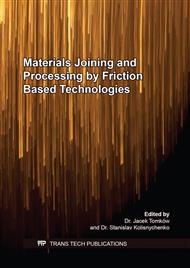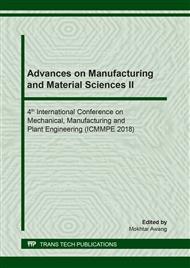[1]
Y. Peng and Z. Yin*, A new strategy for direct tool path generation from measured points,, International journal of production research, vol. 43, pp.933-944, (2005).
DOI: 10.1080/0020754042000298557
Google Scholar
[2]
M. Monreal and C. A. Rodriguez, Influence of tool path strategy on the cycle time of high-speed milling,, Computer-Aided Design, vol. 35, pp.395-401, (2003).
DOI: 10.1016/s0010-4485(02)00060-x
Google Scholar
[3]
B. H. Kim and B. K. Choi, Machining efficiency comparison direction-parallel tool path with contour-parallel tool path,, Computer-Aided Design, vol. 34, pp.89-95, (2002).
DOI: 10.1016/s0010-4485(00)00139-1
Google Scholar
[4]
Z. Yin, Rough and finish tool-path generation for NC machining of freeform surfaces based on a multiresolution method,, Computer-Aided Design, vol. 36, pp.1231-1239, (2004).
DOI: 10.1016/j.cad.2004.01.003
Google Scholar
[5]
S. Ding, M. Mannan, A. N. Poo, D. Yang, and Z. Han, Adaptive iso-planar tool path generation for machining of free-form surfaces,, Computer-Aided Design, vol. 35, pp.141-153, (2003).
DOI: 10.1016/s0010-4485(02)00048-9
Google Scholar
[6]
N. Dialami, M. Chiumenti, M. Cervera, A. Segatori, and W. Osikowicz, Enhanced friction model for Friction Stir Welding (FSW) analysis: Simulation and experimental validation,, International Journal of Mechanical Sciences, vol. 133, pp.555-567, (2017).
DOI: 10.1016/j.ijmecsci.2017.09.022
Google Scholar
[7]
N. Dialami, M. Cervera, and M. Chiumenti, Frictional contact in Friction Stir Welding,, in Congress on Numerical Methods in Engineering CMN2017, 2017, p.5.
Google Scholar
[8]
N. Dialami, M. Chiumenti, M. Cervera, and C. A. de Saracibar, Challenges in thermo-mechanical analysis of friction stir welding processes,, Archives of Computational Methods in Engineering, vol. 24, pp.189-225, (2017).
DOI: 10.1007/s11831-015-9163-y
Google Scholar
[9]
N. Dialami, M. Chiumenti, M. Cervera, and C. A. de Saracibar, Local and global approaches to Friction Stir Welding: International Center for Numerical Methods in Engineering, (2016).
DOI: 10.1016/j.cma.2012.09.013
Google Scholar
[10]
B. Meyghani, M. Awang, S. Emamian, and N. M. Khalid, Developing a Finite Element Model for Thermal Analysis of Friction Stir Welding by Calculating Temperature Dependent Friction Coefficient,, in 2nd International Conference on Mechanical, Manufacturing and Process Plant Engineering, M. Awang, Ed., ed Singapore: Springer Singapore, 2017, pp.107-126.
DOI: 10.1007/978-981-10-4232-4_9
Google Scholar
[11]
B. Meyghani, M. Awang, and S. Emamian, A Mathematical Formulation for Calculating Temperature Dependent Friction Coefficient Values: Application in Friction Stir Welding (FSW),, in Defect and Diffusion Forum, 2017, pp.73-82.
DOI: 10.4028/www.scientific.net/ddf.379.73
Google Scholar
[12]
B. Meyghani, M. Awang, S. S. Emamian, M. K. Mohd Nor, and S. R. Pedapati, A Comparison of Different Finite Element Methods in the Thermal Analysis of Friction Stir Welding (FSW),, Metals, vol. 7, p.450, (2017).
DOI: 10.3390/met7100450
Google Scholar
[13]
H. Su, C. S. Wu, A. Pittner, and M. Rethmeier, Thermal energy generation and distribution in friction stir welding of aluminum alloys,, Energy, vol. 77, pp.720-731, (2014).
DOI: 10.1016/j.energy.2014.09.045
Google Scholar
[14]
F. Lambiase, A. Paoletti, and A. Di Ilio, Forces and temperature variation during friction stir welding of aluminum alloy AA6082-T6,, The International Journal of Advanced Manufacturing Technology, pp.1-10, (2018).
DOI: 10.1007/s00170-018-2524-6
Google Scholar
[15]
B. Meyghani and M. B. Awang, Prediction of the Temperature Distribution During Friction Stir Welding (Fsw) With A Complex Curved Welding Seam: Application In The Automotive Industry,, MATEC Web Conf., vol. 225, // (2018).
DOI: 10.1051/matecconf/201822501001
Google Scholar
[16]
M. A. Ansari, A. Samanta, R. A. Behnagh, and H. Ding, An efficient coupled Eulerian-Lagrangian finite element model for friction stir processing,, The International Journal of Advanced Manufacturing Technology, pp.1-14, (2018).
DOI: 10.1007/s00170-018-3000-z
Google Scholar
[17]
M. Awang, V. Mucino, Z. Feng, and S. David, Thermo-mechanical modeling of friction stir spot welding (FSSW) process: use of an explicit adaptive meshing scheme,, SAE Technical Paper 0148-7191, (2005).
DOI: 10.4271/2005-01-1251
Google Scholar
[18]
H. Bisadi, S. Rasaee, and M. Farahmand, Effects of pin shape on the tool plunge stage in friction stir welding,, Transactions of the Indian Institute of Metals, vol. 67, pp.989-995, (2014).
DOI: 10.1007/s12666-014-0421-8
Google Scholar
[19]
S. Emamian, M. Awang, P. Hussai, B. Meyghani, and A. Zafar, Influences of tool pin profile on the friction stir welding of AA6061,, ARPN Journal of Engineering and Applied Sciences, vol. 11, pp.12258-12261, (2016).
Google Scholar
[20]
Z. Sun, C. Wu, and S. Kumar, Determination of heat generation by correlating the interfacial friction stress with temperature in friction stir welding,, Journal of Manufacturing Processes, vol. 31, pp.801-811, (2018).
DOI: 10.1016/j.jmapro.2018.01.010
Google Scholar
[21]
H. Su, C. S. Wu, M. Bachmann, and M. Rethmeier, Numerical modeling for the effect of pin profiles on thermal and material flow characteristics in friction stir welding,, Materials & Design, vol. 77, pp.114-125, (2015).
DOI: 10.1016/j.matdes.2015.04.012
Google Scholar
[22]
H. Su, C. Wu, A. Pittner, and M. Rethmeier, Simultaneous measurement of tool torque, traverse force and axial force in friction stir welding,, Journal of Manufacturing processes, vol. 15, pp.495-500, (2013).
DOI: 10.1016/j.jmapro.2013.09.001
Google Scholar
[23]
S. Emamian, M. Awang, F. Yusof, P. Hussain, B. Meyghani, and A. Zafar, The Effect of Pin Profiles and Process Parameters on Temperature and Tensile Strength in Friction Stir Welding of AL6061 Alloy,, in The Advances in Joining Technology, ed: Springer, 2018, pp.15-37.
DOI: 10.1007/978-981-10-9041-7_2
Google Scholar
[24]
F. B. Argesi, A. Shamsipur, and S. E. Mirsalehi, Dissimilar Joining of Pure Copper to Aluminum Alloy via Friction Stir Welding,, Acta Metallurgica Sinica (English Letters), vol. 31, pp.1183-1196, (2018).
DOI: 10.1007/s40195-018-0741-5
Google Scholar
[25]
B. Meyghani, M. Awang, and S. Emamian, A COMPARATIVE STUDY OF FINITE ELEMENT ANALYSIS FOR FRICTION STIR WELDING APPLICATION,, (2006).
Google Scholar
[26]
B. Meyghani, M. Awang, S. Emamian, and M. K. B. M. Nor, Thermal Modelling of Friction Stir Welding (FSW) Using Calculated Young's Modulus Values,, in The Advances in Joining Technology, ed: Springer, 2019, pp.1-13.
DOI: 10.1007/978-981-10-9041-7_1
Google Scholar
[27]
B. Meyghani, M. B. Awang, S. Emamian, and E. T. Akinlabi, A comparison between temperature dependent and constant Young's modulus values in investigating the effect of the process parameters on thermal behaviour during friction stir welding,, Materialwissenschaft und Werkstofftechnik, vol. 49, pp.427-434, (2018).
DOI: 10.1002/mawe.201700255
Google Scholar
[28]
A. Warkentin, P. Hoskins, F. Ismail, and S. Bedi, Computer-aided 5-axis machining,, in Systems techniques and computational methods, 2001, pp.3001-3034.
DOI: 10.1201/9781420049893-c3
Google Scholar
[29]
C.-J. Chiou and Y.-S. Lee, A machining potential field approach to tool path generation for multi-axis sculptured surface machining,, Computer-Aided Design, vol. 34, pp.357-371, (2002).
DOI: 10.1016/s0010-4485(01)00102-6
Google Scholar
[30]
E. M. Arkin, M. Held, and C. L. Smith, Optimization problems related to zigzag pocket machining,, Algorithmica, vol. 26, pp.197-236, (2000).
DOI: 10.1007/s004539910010
Google Scholar
[31]
E. M. Arkin, S. P. Fekete, and J. S. Mitchell, Approximation algorithms for lawn mowing and milling☆☆ A preliminary version of this paper was entitled "The lawnmower problem" and appears in the Proc. 5th Canad. Conf. Comput. Geom., Waterloo, Canada, 1993, p.461–466,, Computational Geometry, vol. 17, pp.25-50, (2000).
DOI: 10.1016/s0925-7721(00)00015-8
Google Scholar



